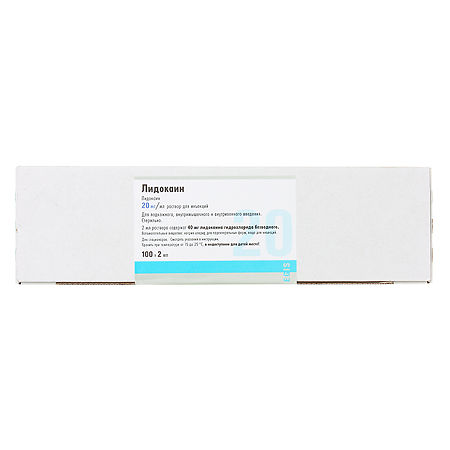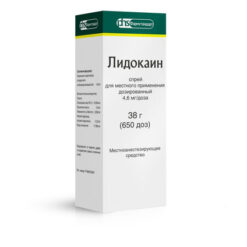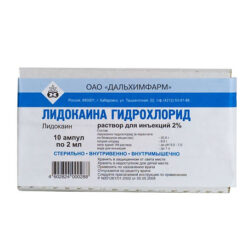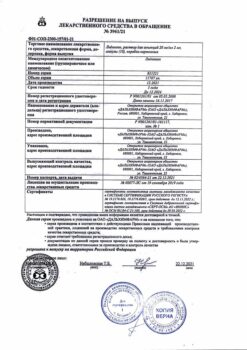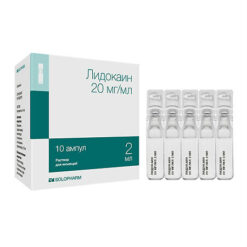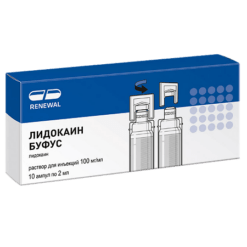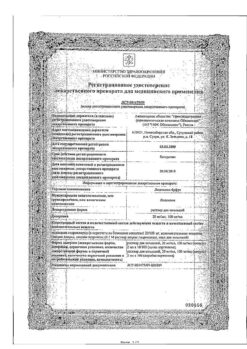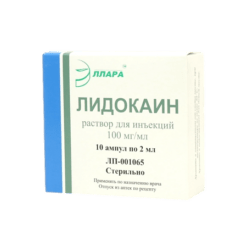No products in the cart.
Lidocaine, 20 mg/ml 2 ml 100 pcs.
€1.00
Out of stock
(E-mail when Stock is available)
Description
Lidocaine is a local anesthetic and antiarrhythmic drug.
The antiarrhythmic activity is due to inhibition of phase 4 (diastolic depolarization) in Purkinje fibers, reduction of automaticity, suppression of ectopic foci of excitation. The rate of rapid depolarization (phase 0) is not affected or slightly reduced.
increases membrane permeability to potassium ions, accelerates the process of repolarization and shortens the action potential. It does not change the excitability of the sinus-atrial node and has little effect on conduction and myocardial contractility. When administered intravenously it works quickly and shortly (10-20 min).
The mechanism of local anesthetic effect consists in stabilization of neuronal membrane, reducing its permeability to sodium ions, which prevents the emergence of action potential and impulse conduction.
Possible antagonism with calcium ions. It is rapidly hydrolyzed in a weakly alkaline environment of tissues and after a short latent period is active for 60-90 minutes. During inflammation (tissue acidosis) anesthetic activity decreases. It is effective for all types of local anesthesia. It dilates blood vessels. It has no irritating effect on the tissues.
When using the drug in pharyngeal or nasopharyngeal surgery the pharyngeal reflex is suppressed.
The drug is good at slowing the cough reflex, which can lead to bronchopneumonia, by reaching the larynx and trachea.
The action of lidocaine in aerosol form develops within 1 min and lasts 5-6 min. The desensitization achieved slowly disappears within 15 min.
It is evenly distributed in the body. It penetrates through the placental barrier.
Indications
Indications
Local anesthesia: superficial, infiltration, conduction, epidural, spinal, intraligamentary in surgical procedures, painful manipulations, endoscopic and instrumental studies.
In dental practice, oral surgery:
In ENT practice:
In endoscopy and instrumental examinations:
In obstetrics and gynecology:
In dermatology:
Active ingredient
Active ingredient
Composition
Composition
Active substance:
Lidocaine hydrochloride;
Auxiliary substances:
sodium chloride,
sodium caustic soda 1 M solution to pH 5.0 – 7.0
water for injection
How to take, the dosage
How to take, the dosage
For local conduction anesthesia the usual dose is 5 ml to 10 ml of Lidocaine 2% solution. For brachial and sacral plexus anesthesia 5-10 ml of 2% solution is administered. For anesthesia of the fingers and toes, 2 ml to 3 ml of 2% solution is administered. The maximum dose of Lidocaine 2% solution is 10 ml, and this dose should not be administered again within 24 hours. In local anesthesia the drug should be injected into highly vascularized tissues with caution to avoid its entry into the bloodstream. Before administering Lidocaine in high doses, administration of barbiturates is recommended.
When used in cardiology, the single dose is 1-2 mg/kg body weight and can be up to a maximum of 100 mg. This dose may be repeated every 3 to 4 minutes up to a total dose of 300 mg.
Intravenous drip is administered at a dose of 20-55 mcg/kg/min, but no more than 2 mg/min in isotonic solution or Ringer’s solution. IV drip infusion is used only after a jet infusion. The duration of IV drip administration is 24-36 hours.
I/m is administered in a dose of 2-4 mg/kg of body weight into the gluteal or deltoid muscle at intervals of 4 h to 6 h. The single dose should not exceed 200 mg.
In myocardial infarction, prior to transporting the patient to the hospital, Lidocaine is administered 4 mg/kg in a single prophylactic dose (200 to 300 mg maximum) in a m/m dose.
Interaction
Interaction
It is undesirable to combine lidocaine with the following drugs:
With beta-adrenoblockers because of increased toxic properties of lidocaine, with digitoxin because of weakened cardiotonic effect, with curare-like drugs – increased muscle relaxation.
Lidocaine should not be administered together with aymalin, amiodarone, verapamil or quinidine due to increased cardiodepressant effect.
Concomitant use of lidocaine and novocainamide may cause CNS agitation and hallucinations.
In intravenous administration of hexenal or thiopental sodium with lidocaine may cause respiratory depression.
MoA inhibitors may increase the local anesthetic effect of lidocaine. Patients taking MAO inhibitors should not administer lidocaine parenterally.
The simultaneous administration of lidocaine and polymyxin-B may increase the inhibitory effect on neuromuscular transmission, so the respiratory function of the patient should be monitored in this case.
The simultaneous use of lidocaine with hypnotics or sedatives may increase their CNS depressant effect. When lidocaine is administered intravenously to patients taking cimetidine such unwanted effects as stunned state, somnolence, bradycardia, parasthesias and others are possible. This is associated with increased plasma levels of lidocaine, which is explained by the release of lidocaine from bonding with blood proteins, as well as a slowdown of its inactivation in the liver. If combination therapy with these drugs is necessary, the dose of lidocaine should be reduced.
Pharmaceutical interaction
When used concomitantly, the following drugs increase the concentration of lidocaine in blood serum: aminazin, cimetidine, propranolol, pethidine, bupivacaine, quinidine, disopyramide, amitriptyline, imipramine, nortriptyline.
Special Instructions
Special Instructions
With caution is used in patients with liver dysfunction, circulatory insufficiency, arterial hypotension, renal failure, epilepsy. In these cases, reduction of the dose of the drug is required.
In rapid intravenous administration there may be a sharp decrease in blood pressure and development of collapse.
In these cases, mesaton, ephedrine and other vasoconstrictors are used. Care should be used when administering lidocaine solutions into highly vascularized tissue to avoid entrapment in the lumen (e.g., neck during thyroid surgery) (Lower doses of lidocaine are indicated in these cases).
Particular caution should be exercised when mucosal trauma is present, when there is mental retardation, and in very old and/or debilitated patients who are already receiving lidocaine-type medications for cardiac problems.
In dentistry and orthopedics, the drug should only be used with elastic impression materials.
Ingestion of the aerosol or contact with the eyes should be avoided and it is important to prevent aerosol from entering the respiratory tract (risk of aspiration). Special care should be taken when applying to the back of the throat. Remember that Lidocaine suppresses the pharyngeal reflex and inhibits the cough reflex, which can lead to aspiration and bronchopneumonia.
Pediatric use
Keep in mind that children have a much more frequent swallowing reflex than adults.
Lidocaine in aerosol form is not recommended for local anesthesia before tonsillectomy and adenotomy in children under 8 years of age.
Influence on driving and operating machinery
If the side effects after using the drug do not cause discomfort, there are no restrictions on driving and operating machinery.
Contraindications
Contraindications
When plaster is used in dentistry as an impression material, aerosol is contraindicated because of the risk of aspiration.
Side effects
Side effects
CNS disorders: headaches, dizziness, somnolence, restlessness, euphoria, tinnitus, numbness of the tongue and mucous membrane of the mouth, speech and vision disorders are possible.
Cardiovascular system disorders: in high doses arterial hypotension, collapse, bradycardia, conduction disorders are possible.
Allergic reactions: rash, itching, exfoliative dermatitis, anaphylactic shock, hyperthermia are rare.
Local reactions: mild burning sensation, which disappears as the anesthetic effect develops (within 1 minute).
Overdose
Overdose
Symptoms: CNS symptoms (including seizures) and cardiovascular symptoms are possible.
Treatment: in case of CNS and cardiovascular system symptoms it is necessary to make sure that the airway is clear, provide fresh air access, oxygen and/or artificial respiration. If convulsions occur, 50-100 mg of ditiline and/or 5-15 mg of diazepam should be administered as soon as possible; barbituric acid derivatives (sodium thiopental) may be used. Dialysis is ineffective in the acute phase of lidocaine overdose.
In case of bradycardia, cardiac conduction abnormalities, atropine 0.5-1 mg IV may be administered.
Pregnancy use
Pregnancy use
The use of Lidocaine in pregnancy should be excluded, because after I.V. injection the drug passes through the placenta after a few minutes.
It is unknown whether lidocaine is excreted with the breast milk. Caution should be exercised when prescribing the drug to a nursing mother.
In lactation, use of the drug is possible after careful assessment of the expected benefit to the mother and the potential risk to the infant.
Similarities
Similarities
Additional information
| Shelf life | 2 years. |
|---|---|
| Conditions of storage | In a dry place protected from light |
| Manufacturer | EGIS, Hungary |
| Brand | EGIS |
Other forms…
Related products
Buy Lidocaine, 20 mg/ml 2 ml 100 pcs. with delivery to USA, UK, Europe and over 120 other countries.

